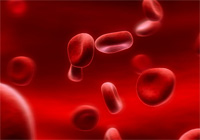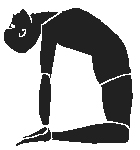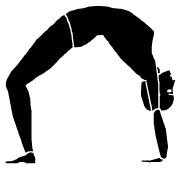Introduction

A red cell has a lifespan of approximately one hundred and twenty days and is then destroyed and replaced. Each person should have about 15 gm of haemoglobin per 100 ml of blood, and a blood count of approximately five million red cells per millimetre of blood. One may be surprised to know that people suffering from anaemia often do not show any prominent symptoms for a long time. However the people suffering from this blood disorder often complain of weakness, lethargy, dizziness etc. When the disease reaches an acute stage, some other perceptible signs appear. These include palpitations, short breath, sourness of gums and mouth and headaches. In some cases, the skin color appears to be pale. If anaemia is left untreated your symptoms will get worse and you may become very tired and weak, you may also develop angina or suffer with leg pains when walking. The body's ability to fight infection may also be weakened so you may find you pick up infections more easily.
Yoga and Anaemia
Regular practice of different yoga poses increases the RBC production as well as purifies the blood. According to various yoga gurus anemic patients should start their yoga session with Pranayama followed by Trikonasana. It improves health thereby attaining eternity. Yoga releases the toxins from the body and tries to be in full harmony with nature with the basic 3 aspects of the human elements: the mind, the mental and the spiritual. Yoga has done wonders to the people suffering from various diseases and had cured them completely from the time of Indus civilization, when the treatment of allopathy was not heard of.Yoga integrates the exercises of aerobics, gymnastics and even combines the mental and physical through breathing, lungs exercise and inhaling of fresh air in to the system. Yoga is a way of life, a conscious act and not a set or series of learning principles. The dexterity, grace, and poise you cultivate as a matter of course is the natural outcome of regular practice. You require no major effort. In fact trying hard will turn your practice into a humdrum, even painful or injurious routine and will eventually slow down your progress. Subsequently and interestingly, the therapeutic effect of yoga is the direct result of involving the mind totally in inspiring (breathing) the body to awaken. One should be gentle and poised.
YOGA POSES FOR ANAEMIA
Sun Salutation
Sun Salutation is one of the more common postures within Yoga. This particular exercise not only stretches your spine and joints, but also works to regulate your breathing, calm your mind, and energize your body. Generally, Sun Salutation is used to begin a set of Yoga exercises. You can use it to begin your day.Stick Pose
This is a recent addition to the traditional asanas, or poses. Developed in the 19th century by Yoga practitioners, it is believed to increase the height of the user. While this benefit may be questioned, the pose induces a state of complete relaxation. An all-body stretch which does not strain even the novice in Yoga, this pose is most easily held while lying down.Corpse Pose
Corpse pose seems very simple on the outside. But this yoga posture can be very difficult when the mind is racing. The Corpse Pose or Savasana may look like a simple relaxing pose that is done in between or after an Asana, but this exercise requires a lot of concentration and will develop through continued practice. This exercise, if done correctly, will stimulate blood circulation and will lessen or relieve fatigue, nervousness, asthma, constipation, diabetes, indigestion, and insomnia. It will also improve one's mental concentration.Camel Pose
Ushtra means a camel. In this asana almost all the limbs of the body are arched like those of a camel. So it is called Ushtrasana.The Camel Yoga Pose helps stretch the front of the body including the chest, abdomen, and quadriceps. It improves spinal flexibility. It is best to practice it later in your asana routine after most of the muscles are limber and and you have worked the back and shoulders.Wheel Pose
Chakra means "wheel," which correlates to both the rolling action of the somersault and the circular shape of the spine as you perform the pose. Through this asana as aspirant can make his spine quit elastic. Elasticity of the spine preserves youth of a very long time. This asana increase height and increase memory power and excess fat also reduces.YOGA ASANAS FOR ANAEMIA
UTTANAPADASANAM

In this asana, thigh muscles and stomach muscles are stretched. The strain reaches inner organs like small intestines, enzyme producing glands and other organs and helps increases their capacity. The vertical position of the legs helps improve the blood circulation.
Steps
- Strecth your body & keep it taut.
- Inhale and raise both legs slowly, placing pressure on your hands.
- Hold your legs at an angle of 60 degrees to the ground, for as long as you can.
- Breathe normally. You should feel maximum pressure on your legs and abdomen. Do not let your face or neck get tense.
- Return the legs slowly to original position. Repeat 3-4 times.
YASTIKASANA
Steps
- Lie on the back. Extend legs fully.
- Inhale 3 seconds stretch arms towards head.
- Stretch toes and fingers outwards.
- Exhaling, return to normal.
- Retain this stretch for 6 seconds, and release the tension of the stretch while exhaling 3 seconds.
SHAVASANA

The benefits of this asana are truly endless. Nothing beats a good bit of relaxation. Do this asana anytime you feel upset or blue. If it's hard to get out of bed in the morning to face the day, use this posture to give you a little better perspective. If you suffer from insomnia, this is a perfect way to end the day.
Steps
- Lie on your back on the floor. Spread the arms out to a 45 degree angle from your sides. Let your legs drop open.
- Keep your head resting comfortably.
- Close your eyes and breathe deeply. Each breath should expand both the chest and belly. Allow your entire body to feel heavy and soft; literally try to relax into the floor.
- Mentally look for places where your body is tense. Should you find tension, focus on that part of the body, tense it and then release. Wiggle your fingers and toes to remove any pressure or stress.
- Try to clear your mind. Continue to breathe deeply.
- Enjoy a conscious state of deep relaxation.
USHTRASANA

This asana tones up the abdominal viscera, particularly the liver, pancreas, kidney and bladder. It expands the chest and strengthens the ribs. It removes sluggishness of the liver. Ulcer and Hernia patients should not do this asana.
Steps
- Raise your buttocks and balance your feet on your toes. There should be a distance of six inches between the knees and between the feet.
- Take your hands back words and grab the heels with your hands. Take care not to lose balance.
- Bend your head backwards as much as possible. Thrust your chest as forward as possible.
- Stay at this pose for a few seconds. Slowly return to original position.
CHAKRASANA

Steps
- Lie flat on your back. Keep the feet sufficiently apart. Stretch your arms on their respective sides with palms turned down.
- Fold the legs and draw the feet back so that the heel of each foot touches the corresponding buttock. Keep the soles flat on the floor.
- Bring your hands backwards and place them on either side of your head. Rest your palms and fingers flat on the floor in the reverse direction beneath the corresponding shoulders. The palms should be in line with the heels.
- Inhaling, press down the hands and feet and raise the thighs, hips, abdomen, trunk and shoulders slowly and simultaneously from the floor. Arch the back and neck and rest the crown of your head firmly on the floor.
- Exhale and inhale a few times and again take a deep breath.
- Hold your breath and press the hands and feet down on the floor. Supporting the weight of your body on your hands and feet, raise your thighs, hips, abdomen, trunk, shoulders and head slowly and simultaneously as far as your spine allows them to do so. The elbows should be straight.
- Bend the whole body backwards as much as possible. The head should drop back between the shoulders.
- Maintain this posture for about ten seconds, holding your breath. Exhaling, lower the body gradually to the floor and resume the starting position.
PASCHIMOTTANASANA

Steps
- This posture involves stretching of the posterior muscles of the body.
- While sitting, stretch your legs forward and keep them close to each other. Bend a little forward, make hooks of your fingers and hold the big toes on the respective sides.
- While exhaling, bend forward stretching the trunk along the thighs. Rest your on the knees, which should be kept straight.
- Gradually, the tense muscles can be made supple for securing the complete posture. Inhale and return to the original position
SARVANGASANA

Steps
- Lie on the back quite flat. Slowly raise the legs.
- Lift the trunk, hips, and legs quite vertically. Support the back with the two hands, one on either side. Rest the elbows on the ground. Press the chin against the chest.
- Allow the back-shoulder portion and neck to touch the ground closely. Do not allow the body to shake or move to and fro. Keep the legs straight.
- When the Asana is over, bring the legs down very, very slowly with elegance and not with any jerks.
- In this Asana the whole weight of the body is thrown on the shoulders. You really stand on the shoulders with the help and support of the elbows.
- Retain the breath as long as you can do with comfort, and slowly exhale through the nose.
Diseases Related to Leo |
||


